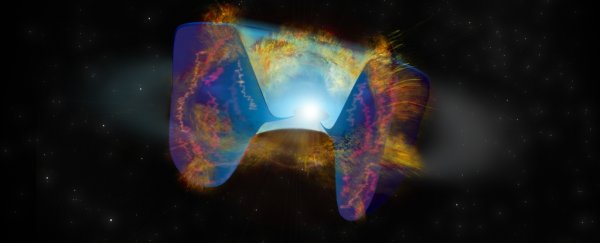The debris from a colossal cosmic explosion in a galaxy hundreds of millions of light-years away is no ordinary supernova.
According to a new analysis of the distant event, it was triggered by a merger between two objects, one of which was compact, either a black hole or a neutron star. The evidence of this event, called VT J121001+495647, is the first observed supernova of its kind.
"Theorists had predicted that this could happen," said astronomer Dillon Dong of Caltech, "but this is the first time we've actually seen such an event."
The supernova was discovered during a 2017 radio survey of the sky, called the Very Large Array Sky Survey (VLASS). During its sweep, the VLA picked up a very brightly glowing radio source that had not appeared in an earlier survey conducted using the same telescope.
Follow-up observations, using both the VLA and the W.M. Keck Observatory which studies the sky in optical and infrared wavelengths, revealed that the radio source did indeed exist, and was consistent with an expanding supernova remnant interacting with dust and gas.
As the fast-moving supernova material expands into that material, shocks and heat are generated, producing electromagnetic radiation so bright that we can detect it, even from other galaxies. Dong and his team traced VT J121001+4959647 to a dwarf galaxy 480 million light-years away.
They also studied archival data of that region of the sky, to determine when VT J121001+4959647 may have started to brighten. They found a burst of soft X-rays picked up in 2014 by the Monitor of All Sky X-ray Image (MAXI) instrument on the International Space Station.
All these observations allowed the researchers to reconstruct the history of the supernova. At least some of the dust and gas heated by the supernova had to come from somewhere. The most likely place, they figured, was the dying star itself.
As one half of a binary system, it could have lost a portion of its gas over time, stripped off by a heavyweight companion.
Such early and significant mass loss is more consistent with a binary star than a singleton, as binary systems tend to transfer mass from one star to another when they reach the end of their lives. This is because the decaying orbit of the system gradually brings them closer together.
We've seen this before; it's not uncommon in lower-mass systems that include a white dwarf star, the collapsed core remnant of a star that was up to eight times the mass of the Sun before it died. Since most stars are thought to be born and live out their lives in binary pairs, it's expected that at least some will die that way, too.
Higher-mass systems, such as binary neutron stars and black holes (the collapsed cores of stars up to and over 30 times the mass of the Sun, respectively) have also been detected by way of gravitational wave astronomy. But the supernova that produced VT J121001+4959647 was not this kind of event.
Instead, according to the team's reconstruction, the two stars were likely born as a binary, with one emerging more massive than the other. Since more massive stars tend to have shorter lives than lesser ones, the chonkier star reached the end of its life first, collapsing into a neutron star or black hole.
As the two objects gradually spiraled closer together in their decaying orbit, this compact dead star started slurping material off its sibling. But this is not a nice, neat process, oh no. Material from the lighter star gets flung every which way, forming into a torus of material orbiting both stars. The team believes this process started about 300 years ago, from our perspective.
Eventually, the two stars merged, the compact massive object reaching and disrupting its companion's core, interrupting the fusion process that supplies outward pressure, and causing the core to collapse – a supernova. But, as the core collapsed, it briefly formed an accretion disc around the intruding star, launching a jet that punched through the kerfuffle and out into space.
This is what produced the X-ray jet spotted by MAXI. And the radio glow detected by VLASS was caused by ejecta from the supernova, which blasted into space much more quickly than the earlier mass loss event. When the supernova ejecta caught up with the earlier material, it slammed into it, causing the glow.
As for the exploding star, its death by supernova was probably only a matter of time – getting body-slammed by a dead stellar core only accelerated the process, the researchers said.
"All the pieces of this puzzle fit together to tell this amazing story," said astronomer Gregg Hallinan of Caltech.
"The remnant of a star that exploded a long time ago plunged into its companion, causing it, too, to explode."
The research has been published in Science.
